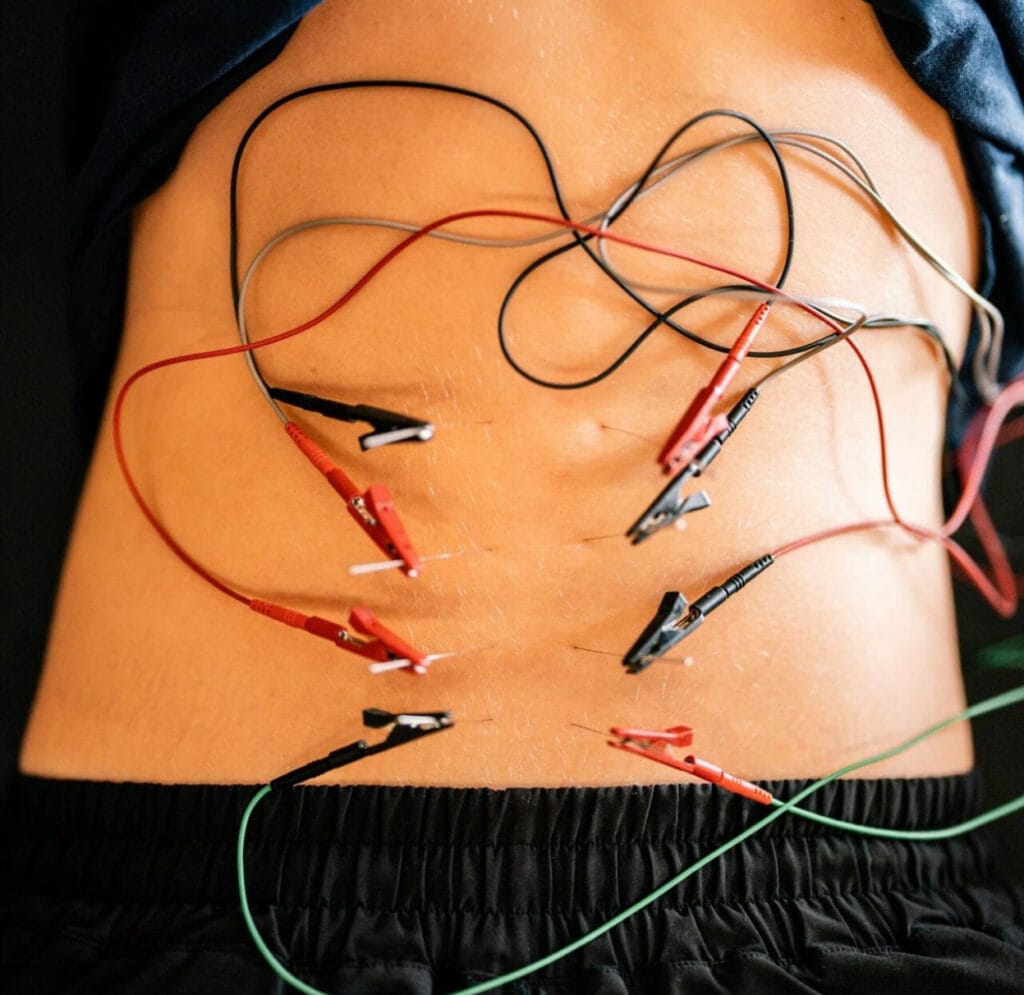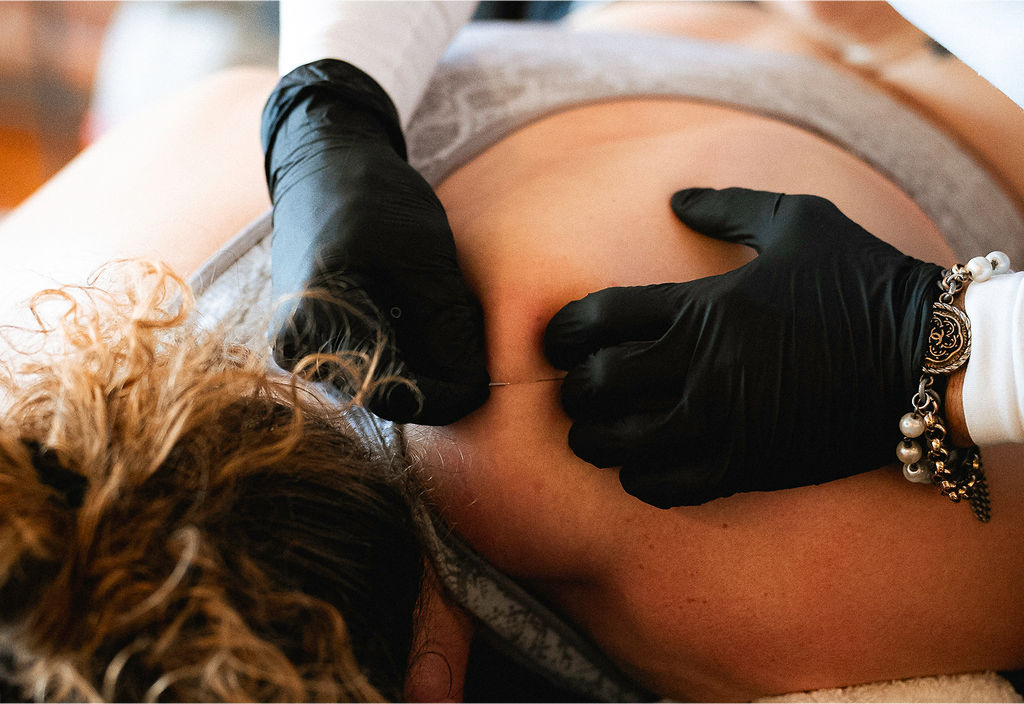Just as you would see a cardiologist for a heart condition, physical therapists are the movement specialists for all kinetic conditions. Among our arsenal of techniques to restore optimal movement, dry needling stands out as a powerful intervention for addressing muscle pain and movement dysfunction when combined with appropriate exercise.
As physical therapists trained in this specialized technique, we use our extensive knowledge of anatomy and physiology to target specific tissue that may be limiting your body’s potential.

Understanding Dry Needling
Dry needling is a physical therapy technique that involves inserting thin monofilament needles into specific target tissue to facilitate healing and recruitment. Unlike the fluid-filled needles used for injections (hence the term “dry”), these solid needles are strategically placed to release muscle tightness and alleviate pain. While it may appear similar to acupuncture, dry needling in physical therapy is firmly rooted in Western medicine and targets anatomical trigger points, rather than focusing on the energy flow pathways used in traditional Chinese medicine.
The science behind dry needling revolves around myofascial trigger points—those tight, painful knots you can feel in your muscles. These trigger points develop when muscles experience prolonged pain, overuse, or injury, creating taut bands of muscle fibers that restrict movement and refer pain to other areas of the body. Our body creates trigger points to protect us or result from an injury; physical therapists taking a holistic overview of the entire body can help determine drivers of these trigger points. Physical therapists who perform trigger point dry needling are trained to identify these problematic areas and use needling work to release them.
Related Article: Dry Needling vs. Acupuncture
How Dry Needling Works
The beauty of dry needling therapy lies in its direct approach to musculoskeletal pain. When sterile needles are inserted into trigger points, they create a local twitch response—a brief contraction followed by relaxation of the muscle. This neurophysiological response helps reset muscle activation patterns and interrupt pain signals being sent to the brain.
Additionally, inserting needles into the subcutaneous tissue increases blood flow to the area, promoting healing and reducing inflammation. The microtrauma created by the needle stimulates your body’s natural healing processes, bringing fresh oxygen and nutrients to tissues that may have been deprived due to muscle tension and restricted circulation.
As physical therapists, we are trained to understand the physics of how our body moves through life. Dry needling treatment addresses the root cause of movement impairments by restoring normal muscle function, which in turn improves biomechanical efficiency and reduces the physical demand on your musculoskeletal system.
Benefits of Dry Needling
The benefits of dry needling extend beyond simple pain relief, though that alone is reason enough for many to seek this treatment.
Here’s what dry needling does for your body:
1 – It helps decrease pain by deactivating trigger points that may be causing both local and referred pain patterns. Whether you’re dealing with chronic pain or an acute muscle strain, dry needling can provide significant relief when performed by a skilled physical therapist.
2 – Dry needling can dramatically improve your range of motion. When muscles are held in constant tension, they restrict normal movement and create compensatory patterns throughout the body. By releasing muscle tightness, dry needling allows joints to move more freely and with less pain.
3 – This technique helps restore proper muscle function. Trigger points can alter muscle activation patterns, leading to weakness, poor coordination, and decreased performance. By addressing these dysfunctional areas, dry needling therapy enables muscles to work more efficiently.
4 – Dry needling can accelerate recovery from musculoskeletal injuries by enhancing tissue healing through increased circulation and normalized muscle tone.

Conditions I Treat with Dry Needling
As an effective technique within sports physical therapy and general orthopedic care, dry needling treatment can address a wide range of musculoskeletal conditions:
- Chronic neck and back pain
- Shoulder impingements and rotator cuff issues
- Tennis elbow and other tendinopathies
- Knee pain from various causes
- Plantar fasciitis
- Muscle strains and tears
- Headaches and migraines with muscular components
- Movement impairments from muscle imbalances
The versatility of dry needling makes it an invaluable tool for physical therapists treating everything from high-level athletes to individuals with prolonged pain from desk jobs or repetitive stress injuries. Dry needling allows us to have a “reset” in movement patterns that we then reinforce with exercise and manual therapy to create an efficient strategy. Reinforcing improvements in movement patterns will facilitate long term healing.
What to Expect in the Dry Needling Process
If you’re considering dry needling, understanding the process can help ease any apprehension.
First, your physical therapist will perform a thorough evaluation, discussing your medical history and current symptoms while identifying movement limitations and painful areas. This systematic approach allows us to pinpoint exactly which muscles require treatment.
During the actual dry needling procedure, you will be positioned comfortably to access the target muscles. Your therapist will clean the area and then insert thin needles into specific trigger points. You might feel a brief pinch as the needle penetrates the skin, followed by a deep ache, muscle twitch, or referral of pain to another area—all positive signs that the needle has hit its target.
Does dry needling hurt? Most of my patients report minimal discomfort during the procedure. The sensation is typically described as a deep pressure or ache rather than sharp pain. The needles used are extremely thin (much finer than those used for injections), which minimizes discomfort.
After treatment, you may experience temporary muscle soreness for 24-48 hours, similar to what you might feel after an intense workout. This is a normal part of the healing process as your body responds to the treatment.
Integration with Other Physical Therapy Techniques
Dry needling doesn’t exist in isolation—it’s one component of a comprehensive physical therapy treatment plan. When results matter, combining dry needling with other physical therapy treatments creates a synergistic effect that addresses not just symptoms but underlying causes of dysfunction.
For example, after releasing trigger points with dry needling, your therapist might prescribe specific exercises to:
- Improve hip flexor mobility
- Enhance hip extensor strength (glut max/med/min)
- Increase ankle dorsiflexion mobility
- Develop thoracic rotation
- Promote adductor mobility
We might also include “neuromuscular reeducation” exercises to focus on proper movement patterns and fostering positions of strength for stability. This comprehensive approach ensures that the improvements gained through dry needling are maintained and built upon.
The Importance of Skilled Practitioners
Not all dry needling is created equal. The effectiveness of this technique depends heavily on the skill and knowledge of the physical therapist performing it. When selecting a provider for dry needling therapy, look for:
- Specialized training in trigger point dry needling
- Experience with your specific condition
- A systematic approach to evaluation and treatment
- Integration of dry needling with other physical therapy techniques
- Competence in anatomy
A skilled physical therapist will not only know where to place the needles but will understand how your pain or movement dysfunction fits into the larger picture of your body’s biomechanics.
Step into Pain-Free Movement with Dry Needling
So there you have it.
You want to move better and with less pain? Here are the key takeaways:
Dry needling is a powerful tool that physical therapists use to release trigger points, increase blood flow, and restore normal muscle function.
When integrated into a comprehensive treatment plan, dry needling can effectively address both acute and chronic pain conditions while improving overall movement quality.
Technology and expertise matter. Could you get benefit from various other therapies? Well, yes. But for targeted release of trigger points and normalization of muscle tissue, few techniques match the precision and effectiveness of dry needling when performed by a skilled physical therapist.
If pain management and improved function matter to you, consider adding dry needling to your recovery toolkit. Just as we mentioned in our discussion of gait analysis, being proactive about addressing movement dysfunctions before they lead to larger problems is key to long-term musculoskeletal health.
Whether you’re dealing with chronic pain or looking to optimize athletic performance, trigger point dry needling might be the missing piece in your treatment plan. Don’t hesitate to reach out to a qualified physical therapist to discuss whether this approach is right for you.